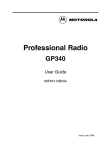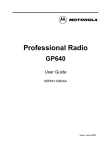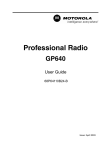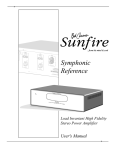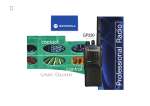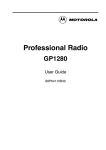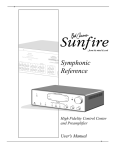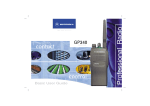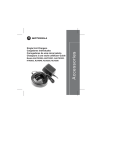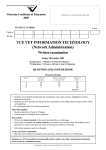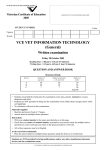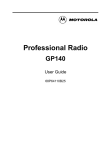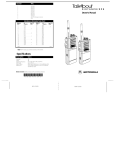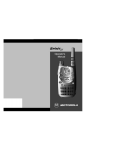Download Motorola Radio GP320 User's Manual
Transcript
Professional Radio GP320 User Guide 68P64110B22A Issue: July 1999 4 3 2 1 5 6 7 8 CONTENTS Operation and Control Functions . . . . . . . . Radio Controls . . . . . . . . . . . . . . . . . . . Programmable Buttons . . . . . . . . . . . . Audio Signal Tones . . . . . . . . . . . . . . . . 3 3 3 5 Getting Started . . . . . . . . . . . . . . . . . . . . . 7 Battery Information. . . . . . . . . . . . . . . . . . . Battery Care and Tips . . . . . . . . . . . . . . Recycling or Disposal of Batteries . . . . Charging the Battery . . . . . . . . . . . . . . . 7 7 8 8 Accessory Information . . . . . . . . . . . . . . 9 Attaching the Battery . . . . . . . . . . . . . . . . . 9 Removing the Battery. . . . . . . . . . . . . . . . . 9 Attaching the Antenna . . . . . . . . . . . . . . . 10 Removing the Antenna. . . . . . . . . . . . . . . 10 Attaching the Belt Clip . . . . . . . . . . . . . . . 11 Removing the Belt Clip. . . . . . . . . . . . . . . 11 Radio Operation . . . . . . . . . . . . . . . . . . . 12 Turning the Radio On-Off. . . . . . . . . . . . . 12 Adjusting the RadioÕs Volume . . . . . . . . . 12 Sending a Call . . . . . . . . . . . . . . . . . . . . . .12 Receiving a Call. . . . . . . . . . . . . . . . . . . . .12 Radio Calls . . . . . . . . . . . . . . . . . . . . . . . .13 Selective Call. . . . . . . . . . . . . . . . . . . . . . .13 Making a Selective Call . . . . . . . . . . . .13 Receiving a Selective Call . . . . . . . . . .14 Emergency Call . . . . . . . . . . . . . . . . . . . . .15 Lone Worker . . . . . . . . . . . . . . . . . . . . . . .16 Features . . . . . . . . . . . . . . . . . . . . . . . . . .17 Transmit Power . . . . . . . . . . . . . . . . . . . . .17 Whisper . . . . . . . . . . . . . . . . . . . . . . . . . .18 Call Forward . . . . . . . . . . . . . . . . . . . . . . .19 Voice Operated Transmit (VOX) . . . . . . . .20 Safety Information . . . . . . . . . . . . . . . . . .21 Safe and Efficient Operation . . . . . . . . . . .21 Exposure to Radio Frequency Energy. . . .21 Radio Operation and EME Exposure . . . .22 Electromagnetic Interference Compatibility . . . . . . . . . . . . . . . . . . . . . . .22 1 English CONTENTS Radio Overview . . . . . . . . . . . . . . . . . . . . 3 CONTENTS Operational Warnings . . . . . . . . . . . . . . . Vehicles with an Air Bag . . . . . . . . . . . Potentially Explosive Atmospheres . . . Batteries . . . . . . . . . . . . . . . . . . . . . . . Blasting Caps and Areas . . . . . . . . . . Operational Cautions . . . . . . . . . . . . . . . . Damaged Antennas . . . . . . . . . . . . . . Batteries . . . . . . . . . . . . . . . . . . . . . . . General Radio Care . . . . . . . . . . . . . . . . . 22 22 22 22 23 23 23 23 23 Computer Software Copyright The products described in this manual may include copyrighted computer programmes stored in semiconductor memories or other media. Laws in the United States of America and other countries preserve for Motorola Europe and Motorola Inc. certain exclusive rights for copyrighted computer programmes, including the right to copy or reproduce in any form the copyrighted computer programme. Accordingly, any copyrighted computer programmes contained in the products described in this manual may not be copied or reproduced in any manner without the express written permission of the holders of the rights. Furthermore, the purchase of these products shall not be deemed to grant either directly or by implication, estoppel, or otherwise, any licence under the copyrights, patents, or patent applications of the holders of the rights, except for the normal non-exclusive royalty free licence to use that arises by operation of the law in the sale of the product. English 2 RADIO OVERVIEW LED Indicator Green: Successful power up. Red: Radio transmitting. Red Flashing: Channel busy - when receiving. Yellow: Radio called. Yellow Flashing: Radio call reminder alert. Red Flashing: Low battery warning - when transmitting. 6. Microphone Speak clearly into the microphone when sending a message. 7. Antenna 8. Accessory Connector Connects headsets, remote speaker/ microphones and other accessories. Replace attached dust cap when not in use. This user guide covers the operation of the GP320 Portable Radio. Please read pages 21 to 23 before using this radio OPERATION AND CONTROL FUNCTIONS Radio Controls The numbers below refer to the illustrations on the inside front cover. 1. On-Off / Volume Knob Used to turn the radio on or off, and to adjust the radioÕs volume. 2. Side Button 1 (programmable) 3. Push to Talk Button (PTT) Press and hold down this button to talk, release it to listen. 4. Side Button 2 (programmable) Programmable Buttons The two side buttons on your radio can be programmed to activate the radio features. The following table shows the features that can be assigned to these buttons. 3 English RADIO OVERVIEW 5. RADIO OVERVIEW Feature Description Monitor/Cancel To monitor the selected channel for any activity or to cancel a current outgoing or incoming call. Radio Call To make an individual or group selective call. Transmit Power To toggle your radioÕs transmit power level between High and Low power Emergency To activate the Emergency alarm call. Lone Worker To identify yourself as a lone worker. Radio enters emergency sequence unless you respond when prompted by pressing any radio button. Call Forward To transfer calls automatically to another radio if you are unable to take the call. Whisper To increase the microphone gain to allow you to speak quietly. English 4 Audio Signal Tones Tone RADIO OVERVIEW High pitched tone Low pitched tone Description Power Up - Radio self-test OK Tone Description Call Reminder Group Call Alert Power Up - Radio self-test Fail. TOT Pre Alert Button Error Monitor Alert Force Monitor(PTT pressed) Call Failed Feature Enable Side Buttons Hardware error - tone continues until valid operation. Feature Disable Side Buttons Lone Worker Reminder Channel Busy / Engaged Individual Call Alert Low Battery Incoming Ringing Tone Outgoing Ringing Tone 5 English RADIO OVERVIEW Tone Description Channel Free Beep Incoming Emergency Alert English 6 ¥ Charging a hot battery (above 35¡C) results in reduced discharge capacity, affecting the performance of the radio. Motorola rapid-rate battery chargers contain a temperature-sensing circuit to ensure that the battery is charged within these temperature limits. This product is powered by a nickel-cadmium (Ni-Cd), nickel-metal-hydride (NiMH), or lithium-ion rechargeable battery. ¥ New batteries can be stored up to two years without signiÞcant cycle loss. Store new/unused batteries, at room temperature, in cool dry area. The following battery tips will help you obtain the highest performance and longest cycle life from your Motorola rechargeable battery. ¥ Batteries which have been in storage should be charged overnight. ¥ Do not return fully charged batteries to the charger for an Òextra boostÓ. This action will signiÞcantly reduce cycle life. ¥ Do not leave your radio and battery in the charger when not charging. Continuous charging will shorten battery life. (Do not use your charger as a radio stand.) ¥ For optimum battery life and operation use only Motorola brand chargers. They were designed to operate as an integrated energy system. BATTERY INFORMATION Battery Care and Tips ¥ Charge your new battery overnight (14-16 hrs) before using it to obtain maximum battery capacity and performance. ¥ Charging in non-Motorola equipment may lead to battery damage and void the battery warranty. ¥ When charging a battery that is attached to the radio, turn the radio off to ensure a full charge. ¥ The battery should be at about 25¡C (room temperature) whenever possible. Charging a cold battery (below 10¡C) may result in leakage of electrolyte and ultimately, in failure of the battery. 7 English GETTING STARTED GETTING STARTED GETTING STARTED Recycling or Disposal of Batteries Charger LED NiCd At the end of its useful life, the NiCd battery can be recycled. However, recycling facilities may not be available in all areas. Motorola endorses and encourages the recycling of all re-chargeable batteries. Contact your local Motorola dealer for further information. Charging the Battery If a battery is new, or its charge level is very low, you will need to charge the battery before you can use it in your radio. Please contact your dealer for further information. Note: Batteries are shipped uncharged from the factory. New batteries could prematurely indicate full charge, charge a new battery for 14-16 hrs before initial use. Red Battery is charging Green Battery is fully charged Flashing Red * Battery is unchargeable Flashing Yellow Charger is getting ready to charge Flashing Green Battery is 90% charged * Battery is damaged. Please contact your dealer. 1. Place the radio with the battery attached, or the battery alone, in the charger. 2. The chargerÕs LED indicates the charging progress. Battery chargers will charge only the Motorola authorized batteries listed below; other batteries will not charge. Part No. HNN9008 HNN9009 HNN9010 HNN9011 HNN9012 HNN9013 Description High-Capacity NiMH Ultra-High-Capacity NiMH Ultra-High-Capacity FM NiMH High-Capacity FM NiCd High-Capacity NiCd Lithium-Ion FM - Factory mutual English 8 Status ACCESSORY INFORMATION GETTING STARTED Attaching the Battery Removing the Battery Battery Latches 2 2 3 1 Slots 1. Fit the extensions at the bottom of the battery into the slots at the bottom of the radioÕs body. 2. Press the top part of the battery towards the radio until you hear a click. 1. Turn off the radio, if it is turned on. 2. Slide the battery latches, on both sides of the battery, downwards. 3. Pull the top part of the battery away from the radioÕs body, and remove the battery. 9 English Removing the Antenna 1. Align the threaded end of the antenna with the radioÕs antenna connector. 1. 2. Turn the antenna clockwise to fasten it. GETTING STARTED Attaching the Antenna English 10 Turn the antenna counterclockwise until you can remove it. Attaching the Belt Clip Removing the Belt Clip GETTING STARTED Belt Clip Tab 1 2 1. Align the grooves of the belt clip with those of the battery. 1. Use a key to press the belt clip tab away from the battery. 2. Press the belt clip downwards until a click is heard. 2. Slide the belt clip upwards to remove it. 11 English GETTING STARTED TURNING THE RADIO ON OR OFF SENDING A CALL 1. Press the PTT button and speak clearly into the microphone. Your mouth should be about 2.5 to 5 cm away from the microphone. 2. Release the PTT button when you Þnish speaking. RECEIVING A CALL ON OFF ¥ To turn the radio on, turn the On-Off/Volume Control knob clockwise. ¥ To turn the radio off, turn the On-Off/Volume Control knob counterclockwise until you hear a click. ADJUSTING THE RADIOÕS VOLUME ¥ Turn the On-Off/Volume Control knob to adjust the volume level. English 12 1. Turn your radio on and adjust the volume level 2. If, at any time, a call is received, you will hear the call at the volume level you have set. RADIO CALLS Making a Selective Call You can make a selective call, to a particular radio, known as an individual call, or group of radios, known as a group call. To make a Selective Call : 1. Press the PTT or Call Button (depending on the way your radio has been programmed by your dealer) to set up the call. 2. Wait until the conversation has been setup, which means you are authorised to use the system. 3. Talk with your mouth 2.5 - 5cm from the microphone. Release PTT to listen. 4. When transmitting the red indicator will light continuously. 13 English RADIO CALLS SELECTIVE CALL Your radio may be conÞgured for ÔTransmit InhibitÕ under certain conditions (e.g. when the channel is in use by others) in which case, the channel busy tone will sound when you press the PTT or call button to indicate that transmission is inhibited. When the channel is free, the Channel Free beep will sound, and you can make a call. If your radio is equipped with a transmit time out timer (TOT), a warning tone will sound a few seconds before the transmission is cut off. Your radio may be programmed to inhibit retransmission within a preset time. RADIO CALLS Receiving a Selective Call When you receive a selective call, you will hear either an individual call alert tone , or a group call alert tone and the LED Indicator will light (yellow). To answer the call: 1. Press the PTT button or Call button. 2. The call will terminate automatically when the conversation has ended or press the Monitor button. English 14 EMERGENCY CALL Should you receive an Emergency call the incoming emergency alert tone will sound. When you make an Emergency call, your radio goes into an Emergency state, which can be programmed to: ¥ continually give audio feedback, ¥ give no audio feedback; the radio can receive and transmit. 1. Press the Emergency button to initiate an Emergency call. 2. Emergency can be stopped by: ¥ Switching the radio Off and On again. ¥ A reset message is received by your radio. ¥ The emergency time duration is reached. Note: The emergency time duration and reset message are programmed into your radio by your dealer. 15 English RADIO CALLS Your radio can be programmed to give you a one-button quick access to call a particular radio or centre (predeÞned by your dealer) in emergency situations. This is the Emergency Call. RADIO CALLS LONE WORKER The Lone Worker feature enables you to work alone with added safety. To use this feature : 1. Press the Lone Worker button. 2. The feature enable alert will sound. You will be reminded at intervals that Lone Worker is switched on by a high pitched alert being sounded . ¥ Press any button to respond and cancel the alert, if you do not the radio will enter the Emergency state. To switch off this feature: 1. Press the Lone Worker button when the feature disable alert will sound or, 2. Change the channel or, 3. Switch radio off and on again. English 16 FEATURES You can transmit your calls at different transmit power levels. A higher level means you can reach a radio that is farther away. A lower power level conserves battery power. You are advised to transmit as frequently as possible on low power, and use high power only when needed. To use this feature : 1. Press the Tx Power button to switch to high power when the feature enable alert will sound. 2. Press the Tx Power button again to switch to low power when the feature disable alert will sound. 17 English FEATURES The features described below are programmed into your radio by your dealer and are accessible via the radioÕs programmable buttons. TRANSMIT POWER FEATURES WHISPER Whisper allows you to talk quietly into the radio microphone when making a call. To switch Whisper on: 1. Press the Whisper button once, when the feature enable alert will sound. To switch Whisper off: 1. Press the Whisper button again, when the feature disable alert will sound. English 18 CALL FORWARD 1. FEATURES You can call forward calls to your radio to another radio if you are unable to take calls or are away from your radio. To enable Call Forward: Press the Call Forward button once, when the feature enable alert will sound. To disable Call Forward: 1. Press the Call Forward button again, when the feature disable alert will sound. 19 English FEATURES VOICE OPERATED TRANSMIT (VOX) When the VOX headset/microphone is connected, your radio may be used with hands-free operation. To start the VOX feature: 1. Connect the VOX headset onto the accessory connector of the radio. 2. Switch On the radio. You can disable the VOX feature by pressing the PTT button on the radio. This allows you to use the VOX headset but you must press the radio PTT to transmit. To re-enable the VOX feature: 1. Switch the OFF and ON again with the headset connected to the accessory connector. 2. Change channel with the VOX headset connected. English 20 SAFETY INFORMATION This section provides information and instructions for the safe and efÞcient operation of Motorola Portable and Mobile Two-Way Radios. For information regarding radio use in hazardous areas, please refer to the Factory Mutual (FM) approval manual supplement or Instruction Card which is included with radio models that offer this capability. Exposure To Radio Frequency Energy National and International Standards and Guidelines Your Motorola Two-Way Radio, which generates and radiates radio frequency (RF) electromagnetic energy (EME) is designed to comply with the following National and International Standards and Guidelines regarding exposure of human beings to radio frequency electromagnetic energy: ¥ Federal Communications Commission Report and Order No. FCC 96-326 (August 1996) ¥ American National Standards Institute (C95.1 - 1992) National Council on Radiation Protection and Measurements (NCRP - 1986) ¥ International Commission on Non-Ionizing Radiation Protection (ICNRP - 1986) ¥ European Committee for Electrotechnical Standardisation (CENELEC): ¥ ENV. 50166-1 1995 E Human Exposure to Electromagnetic Fields Low Frequency (0Hz to 10kHz) ¥ ENV. 50166-2 1995 E Human Exposure to Electromagnetic Fields High Frequency (10kHz to 300GHz) ¥ Proceedings of SC211/8 1996 Safety Considerations for Human Exposure to E.M.F.s from Mobile Telecommunications Equipment (M.T.E.) in the Frequency Range 30MHz - 6 GHz (E.M.F. Electromagnetic Fields) To assure optimal radio performance and that human exposure to radio frequency electromagnetic energy is within the guidelines set forth in the above standards, always adhere to the following procedures: 21 English SAFETY Safe and EfÞcient Operation of Motorola Two-Way Radios ¥ SAFETY Portable Radio Operation and EME Exposure Operational Warnings ! When transmitting with a portable radio, hold the radio in a vertical position with its microphone 1 to 2 inches (2.5 to 5 centimeters) away from your mouth. Keep antenna at least 1 inch (2.5 centimeters) from your head and body. If you wear a portable two-way radio on your body, ensure that the antenna is at least 1 inch (2.5 centimeters) from your body when transmitting. MAN WITH RA Electromagnetic Interference/Compatibility Note: Nearly every electronic device is susceptible to electromagnetic interference (EMI) if inadequately shielded, designed or otherwise conÞgured for electromagnetic compatibility. To avoid electromagnetic interference and/or compatibility conßicts, turn off your radio in any facility where posted notices instruct you to do so. Hospitals or health care facilities may be using equipment that is sensitive to external RF energy. When instructed to do so, turn off your radio when on board an aircraft. Any use of a radio must be in accordance with airline regulations or crew instructions. English 22 Vehicles With an Air Bag WARNING Do not place a portable radio in the area over an air bag or in the air bag deployment area. Air bags inßate with great force. If a portable radio is placed in the air bag deployment area and the air bag inßates, the radio may be propelled with great force and cause serious injury to occupants of the vehicle. Potentially Explosive Atmospheres Turn off your two-way radio when you are in any area with a potentially explosive atmosphere, unless it is a radio type especially qualiÞed for use in such areas (for example, Factory Mutual or CENELEC Approved). Sparks in a potentially explosive atmosphere can cause an explosion or Þre resulting in bodily injury or even death. Batteries Do not replace or recharge batteries in a potentially explosive atmosphere. Contact sparking may occur while installing or removing batteries and cause an explosion. Batteries To avoid possible interference with blasting operations, turn off your radio when you are near electrical blasting caps, in a blasting area, or in areas posted: ÒTurn off two-way radio.Ó Obey all signs and instructions. All batteries can cause property damage and/or bodily injury such as burns if a conductive material such as jewellery, keys, or beaded chains touch exposed terminals. The conductive material may complete an electrical circuit (short circuit) and become quite hot. Exercise care in handling any charged battery, particularly when placing it inside a pocket, purse, or other container with metal objects. Note: The areas with potentially explosive atmospheres referred to above include fueling areas such as: below decks on boats; fuel or chemical transfer or storage facilities; areas where the air contains chemicals or particles, such as grain, dust or metal powders; and any other area where you would normally be advised to turn off your vehicle engine. Areas with potentially explosive atmospheres are often but not always posted. ! ¥ The use of chemicals such as detergents, alcohol, aerosol Caution sprays, and/or petroleum products may be harmful to and damage the radio housing. ¥ Avoid physical abuse of the radio such as carrying it by the antenna. Operational Cautions ! Damaged Antennas General Radio Care Caution Do not use any portable two-way radio that has a damaged antenna. If a damaged antenna comes into contact with your skin, a minor burn can result. ¥ The accessory connector (if Þtted) has a protective cap which should be left in place when the connector is not in use. ¥ Clean the radio exterior using a cloth moistened with clean water and a mild dishwashing liquid. ¥ The use of non-approved radio accessories may damage the radio and invalidate warranty. 23 English SAFETY Blasting Caps and Areas NOTES NOTES English 24


























